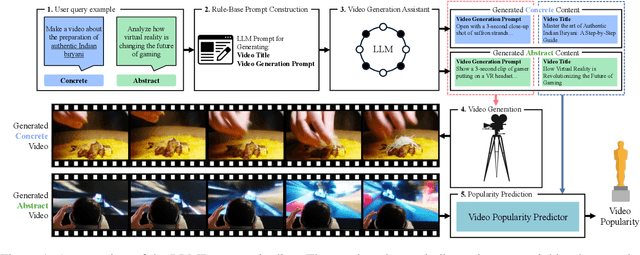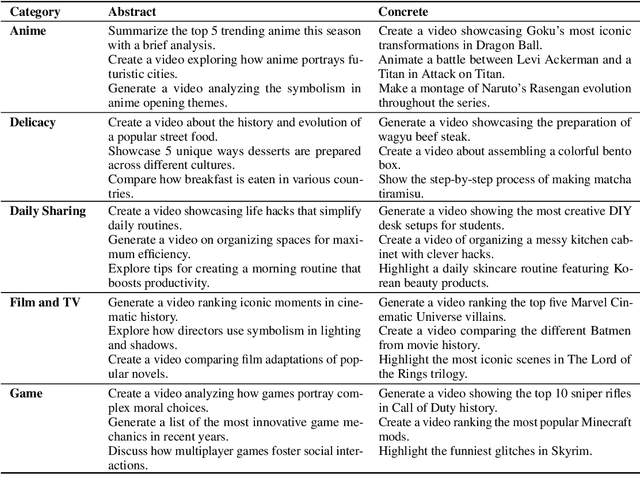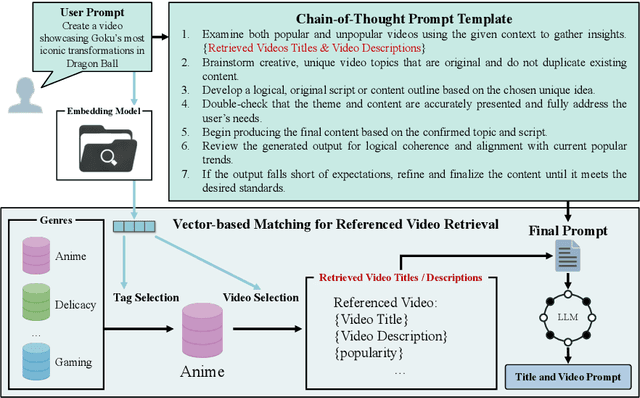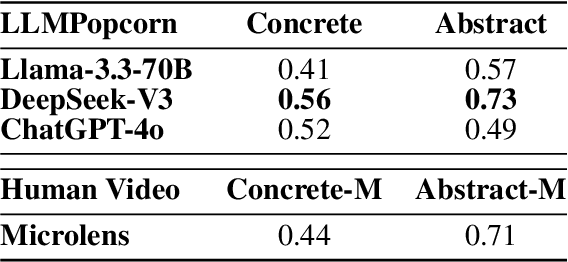Kaiwen Zheng
Vidarc: Embodied Video Diffusion Model for Closed-loop Control
Dec 19, 2025Abstract:Robotic arm manipulation in data-scarce settings is a highly challenging task due to the complex embodiment dynamics and diverse contexts. Recent video-based approaches have shown great promise in capturing and transferring the temporal and physical interactions by pre-training on Internet-scale video data. However, such methods are often not optimized for the embodiment-specific closed-loop control, typically suffering from high latency and insufficient grounding. In this paper, we present Vidarc (Video Diffusion for Action Reasoning and Closed-loop Control), a novel autoregressive embodied video diffusion approach augmented by a masked inverse dynamics model. By grounding video predictions with action-relevant masks and incorporating real-time feedback through cached autoregressive generation, Vidarc achieves fast, accurate closed-loop control. Pre-trained on one million cross-embodiment episodes, Vidarc surpasses state-of-the-art baselines, achieving at least a 15% higher success rate in real-world deployment and a 91% reduction in latency. We also highlight its robust generalization and error correction capabilities across previously unseen robotic platforms.
TurboDiffusion: Accelerating Video Diffusion Models by 100-200 Times
Dec 18, 2025Abstract:We introduce TurboDiffusion, a video generation acceleration framework that can speed up end-to-end diffusion generation by 100-200x while maintaining video quality. TurboDiffusion mainly relies on several components for acceleration: (1) Attention acceleration: TurboDiffusion uses low-bit SageAttention and trainable Sparse-Linear Attention (SLA) to speed up attention computation. (2) Step distillation: TurboDiffusion adopts rCM for efficient step distillation. (3) W8A8 quantization: TurboDiffusion quantizes model parameters and activations to 8 bits to accelerate linear layers and compress the model. In addition, TurboDiffusion incorporates several other engineering optimizations. We conduct experiments on the Wan2.2-I2V-14B-720P, Wan2.1-T2V-1.3B-480P, Wan2.1-T2V-14B-720P, and Wan2.1-T2V-14B-480P models. Experimental results show that TurboDiffusion achieves 100-200x speedup for video generation even on a single RTX 5090 GPU, while maintaining comparable video quality. The GitHub repository, which includes model checkpoints and easy-to-use code, is available at https://github.com/thu-ml/TurboDiffusion.
DiffusionNFT: Online Diffusion Reinforcement with Forward Process
Sep 19, 2025Abstract:Online reinforcement learning (RL) has been central to post-training language models, but its extension to diffusion models remains challenging due to intractable likelihoods. Recent works discretize the reverse sampling process to enable GRPO-style training, yet they inherit fundamental drawbacks, including solver restrictions, forward-reverse inconsistency, and complicated integration with classifier-free guidance (CFG). We introduce Diffusion Negative-aware FineTuning (DiffusionNFT), a new online RL paradigm that optimizes diffusion models directly on the forward process via flow matching. DiffusionNFT contrasts positive and negative generations to define an implicit policy improvement direction, naturally incorporating reinforcement signals into the supervised learning objective. This formulation enables training with arbitrary black-box solvers, eliminates the need for likelihood estimation, and requires only clean images rather than sampling trajectories for policy optimization. DiffusionNFT is up to $25\times$ more efficient than FlowGRPO in head-to-head comparisons, while being CFG-free. For instance, DiffusionNFT improves the GenEval score from 0.24 to 0.98 within 1k steps, while FlowGRPO achieves 0.95 with over 5k steps and additional CFG employment. By leveraging multiple reward models, DiffusionNFT significantly boosts the performance of SD3.5-Medium in every benchmark tested.
Are Multimodal Embeddings Truly Beneficial for Recommendation? A Deep Dive into Whole vs. Individual Modalities
Aug 10, 2025Abstract:Multimodal recommendation (MMRec) has emerged as a mainstream paradigm, typically leveraging text and visual embeddings extracted from pre-trained models such as Sentence-BERT, Vision Transformers, and ResNet. This approach is founded on the intuitive assumption that incorporating multimodal embeddings can enhance recommendation performance. However, despite its popularity, this assumption lacks comprehensive empirical verification. This presents a critical research gap. To address it, we pose the central research question of this paper: Are multimodal embeddings truly beneficial for recommendation? To answer this question, we conduct a large-scale empirical study examining the role of text and visual embeddings in modern MMRec models, both as a whole and individually. Specifically, we pose two key research questions: (1) Do multimodal embeddings as a whole improve recommendation performance? (2) Is each individual modality - text and image - useful when used alone? To isolate the effect of individual modalities - text or visual - we employ a modality knockout strategy by setting the corresponding embeddings to either constant values or random noise. To ensure the scale and comprehensiveness of our study, we evaluate 14 widely used state-of-the-art MMRec models. Our findings reveal that: (1) multimodal embeddings generally enhance recommendation performance - particularly when integrated through more sophisticated graph-based fusion models. Surprisingly, commonly adopted baseline models with simple fusion schemes, such as VBPR and BM3, show only limited gains. (2) The text modality alone achieves performance comparable to the full multimodal setting in most cases, whereas the image modality alone does not. These results offer foundational insights and practical guidance for the MMRec community. We will release our code and datasets to facilitate future research.
Bridging Supervised Learning and Reinforcement Learning in Math Reasoning
May 23, 2025Abstract:Reinforcement Learning (RL) has played a central role in the recent surge of LLMs' math abilities by enabling self-improvement through binary verifier signals. In contrast, Supervised Learning (SL) is rarely considered for such verification-driven training, largely due to its heavy reliance on reference answers and inability to reflect on mistakes. In this work, we challenge the prevailing notion that self-improvement is exclusive to RL and propose Negative-aware Fine-Tuning (NFT) -- a supervised approach that enables LLMs to reflect on their failures and improve autonomously with no external teachers. In online training, instead of throwing away self-generated negative answers, NFT constructs an implicit negative policy to model them. This implicit policy is parameterized with the same positive LLM we target to optimize on positive data, enabling direct policy optimization on all LLMs' generations. We conduct experiments on 7B and 32B models in math reasoning tasks. Results consistently show that through the additional leverage of negative feedback, NFT significantly improves over SL baselines like Rejection sampling Fine-Tuning, matching or even surpassing leading RL algorithms like GRPO and DAPO. Furthermore, we demonstrate that NFT and GRPO are actually equivalent in strict-on-policy training, even though they originate from entirely different theoretical foundations. Our experiments and theoretical findings bridge the gap between SL and RL methods in binary-feedback learning systems.
Multimodal Representation Learning Techniques for Comprehensive Facial State Analysis
Apr 14, 2025



Abstract:Multimodal foundation models have significantly improved feature representation by integrating information from multiple modalities, making them highly suitable for a broader set of applications. However, the exploration of multimodal facial representation for understanding perception has been limited. Understanding and analyzing facial states, such as Action Units (AUs) and emotions, require a comprehensive and robust framework that bridges visual and linguistic modalities. In this paper, we present a comprehensive pipeline for multimodal facial state analysis. First, we compile a new Multimodal Face Dataset (MFA) by generating detailed multilevel language descriptions of face, incorporating Action Unit (AU) and emotion descriptions, by leveraging GPT-4o. Second, we introduce a novel Multilevel Multimodal Face Foundation model (MF^2) tailored for Action Unit (AU) and emotion recognition. Our model incorporates comprehensive visual feature modeling at both local and global levels of face image, enhancing its ability to represent detailed facial appearances. This design aligns visual representations with structured AU and emotion descriptions, ensuring effective cross-modal integration. Third, we develop a Decoupled Fine-Tuning Network (DFN) that efficiently adapts MF^2 across various tasks and datasets. This approach not only reduces computational overhead but also broadens the applicability of the foundation model to diverse scenarios. Experimentation show superior performance for AU and emotion detection tasks.
* Accepted by ICME2025
CROSSAN: Towards Efficient and Effective Adaptation of Multiple Multimodal Foundation Models for Sequential Recommendation
Apr 14, 2025Abstract:Multimodal Foundation Models (MFMs) excel at representing diverse raw modalities (e.g., text, images, audio, videos, etc.). As recommender systems increasingly incorporate these modalities, leveraging MFMs to generate better representations has great potential. However, their application in sequential recommendation remains largely unexplored. This is primarily because mainstream adaptation methods, such as Fine-Tuning and even Parameter-Efficient Fine-Tuning (PEFT) techniques (e.g., Adapter and LoRA), incur high computational costs, especially when integrating multiple modality encoders, thus hindering research progress. As a result, it remains unclear whether we can efficiently and effectively adapt multiple (>2) MFMs for the sequential recommendation task. To address this, we propose a plug-and-play Cross-modal Side Adapter Network (CROSSAN). Leveraging the fully decoupled side adapter-based paradigm, CROSSAN achieves high efficiency while enabling cross-modal learning across diverse modalities. To optimize the final stage of multimodal fusion across diverse modalities, we adopt the Mixture of Modality Expert Fusion (MOMEF) mechanism. CROSSAN achieves superior performance on the public datasets for adapting four foundation models with raw modalities. Performance consistently improves as more MFMs are adapted. We will release our code and datasets to facilitate future research.
Direct Discriminative Optimization: Your Likelihood-Based Visual Generative Model is Secretly a GAN Discriminator
Mar 03, 2025Abstract:While likelihood-based generative models, particularly diffusion and autoregressive models, have achieved remarkable fidelity in visual generation, the maximum likelihood estimation (MLE) objective inherently suffers from a mode-covering tendency that limits the generation quality under limited model capacity. In this work, we propose Direct Discriminative Optimization (DDO) as a unified framework that bridges likelihood-based generative training and the GAN objective to bypass this fundamental constraint. Our key insight is to parameterize a discriminator implicitly using the likelihood ratio between a learnable target model and a fixed reference model, drawing parallels with the philosophy of Direct Preference Optimization (DPO). Unlike GANs, this parameterization eliminates the need for joint training of generator and discriminator networks, allowing for direct, efficient, and effective finetuning of a well-trained model to its full potential beyond the limits of MLE. DDO can be performed iteratively in a self-play manner for progressive model refinement, with each round requiring less than 1% of pretraining epochs. Our experiments demonstrate the effectiveness of DDO by significantly advancing the previous SOTA diffusion model EDM, reducing FID scores from 1.79/1.58 to new records of 1.30/0.97 on CIFAR-10/ImageNet-64 datasets, and by consistently improving both guidance-free and CFG-enhanced FIDs of visual autoregressive models on ImageNet 256$\times$256.
LLMPopcorn: An Empirical Study of LLMs as Assistants for Popular Micro-video Generation
Feb 19, 2025



Abstract:Popular Micro-videos, dominant on platforms like TikTok and YouTube, hold significant commercial value. The rise of high-quality AI-generated content has spurred interest in AI-driven micro-video creation. However, despite the advanced capabilities of large language models (LLMs) like ChatGPT and DeepSeek in text generation and reasoning, their potential to assist the creation of popular micro-videos remains largely unexplored. In this paper, we conduct an empirical study on LLM-assisted popular micro-video generation (LLMPopcorn). Specifically, we investigate the following research questions: (i) How can LLMs be effectively utilized to assist popular micro-video generation? (ii) To what extent can prompt-based enhancements optimize the LLM-generated content for higher popularity? (iii) How well do various LLMs and video generators perform in the popular micro-video generation task? By exploring these questions, we show that advanced LLMs like DeepSeek-V3 enable micro-video generation to achieve popularity comparable to human-created content. Prompt enhancements further boost popularity, and benchmarking highlights DeepSeek-V3 and DeepSeek-R1 among LLMs, while LTX-Video and HunyuanVideo lead in video generation. This pioneering work advances AI-assisted micro-video creation, uncovering new research opportunities. We will release the code and datasets to support future studies.
Elucidating the Preconditioning in Consistency Distillation
Feb 05, 2025Abstract:Consistency distillation is a prevalent way for accelerating diffusion models adopted in consistency (trajectory) models, in which a student model is trained to traverse backward on the probability flow (PF) ordinary differential equation (ODE) trajectory determined by the teacher model. Preconditioning is a vital technique for stabilizing consistency distillation, by linear combining the input data and the network output with pre-defined coefficients as the consistency function. It imposes the boundary condition of consistency functions without restricting the form and expressiveness of the neural network. However, previous preconditionings are hand-crafted and may be suboptimal choices. In this work, we offer the first theoretical insights into the preconditioning in consistency distillation, by elucidating its design criteria and the connection to the teacher ODE trajectory. Based on these analyses, we further propose a principled way dubbed \textit{Analytic-Precond} to analytically optimize the preconditioning according to the consistency gap (defined as the gap between the teacher denoiser and the optimal student denoiser) on a generalized teacher ODE. We demonstrate that Analytic-Precond can facilitate the learning of trajectory jumpers, enhance the alignment of the student trajectory with the teacher's, and achieve $2\times$ to $3\times$ training acceleration of consistency trajectory models in multi-step generation across various datasets.
 Add to Chrome
Add to Chrome Add to Firefox
Add to Firefox Add to Edge
Add to Edge